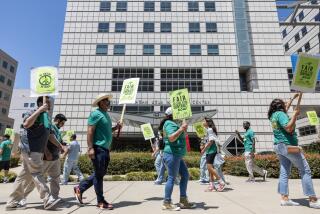Veterans of UFW Battles Gather to Pay Tribute : CSUN: At symposium, former organizers honor Cesar Chavez and the union’s role in the state’s labor history.
- Share via
NORTHRIDGE — As they did for so many marches in the turbulent 1960s and ‘70s, they came from throughout the country to support the man and the cause. But instead of placards and flags, they now came armed with memories and words to keep alive the dream of Cesar Chavez and the United Farm Workers union.
Since Thursday, former organizers of the UFW have been trickling onto the campus of Cal State Northridge for a three-day symposium, La Lucha Continua (The Struggle Continues), to recognize and preserve the memory of the role the UFW played in California labor history.
“I’m just here to add my few grains of sand,” said Julio Hernandez, 74, a former vice president and former president of the UFW’s credit union. “I was one of the first to be videotaped on Thursday, but as people come in and we start talking, I remember things I forgot to say during my interview.”
The recording of oral histories will continue today, but participants will take a break at 3 p.m. for an outdoor rally on the North Campus, west of the football field, featuring Dolores Huerta, UFW vice president and co-founder. In case of rain, the rally will be moved to the Northridge United Methodist Church at Reseda Boulevard and Superior Street.
Immediately after the rally, there will be a symbolic march to the university’s art gallery for the opening of two exhibitions.
One exhibit is of strike and boycott posters from the Center for the Study of Political Graphics.
The other is an exhibit of photographs by George Elfie Ballis, who documented the UFW’s early years.
Both exhibits, plus a display of historical documents of the farm labor movement, on the first floor of Oviatt Library, will remain through April 7.
The symposium was organized by Jorge Garcia, dean of humanities, and Kent Kirkton, director of CSUN’s Center for Photojournalism and Visual History, who got the idea as they drove back from Chavez’s funeral two years ago.
“The talk then was of how it was the end of an era because Chavez was dead,” Kirkton said. “We decided that the movement was the people and we wanted to celebrate that.”
Garcia said it is appropriate for CSUN to house the collection of documents and oral histories because the campus has the largest Chicano studies department in the country.
“We want to begin housing a collection of support documents because in 100 years we want people to be able to come into the library and see the history of the UFW,” he said.
“So many people have been part of this movement that we can draw people to a center here for the history of the Chicano/Latino labor movement.”
Garcia said it is a coincidence that the symposium is taking place after what some Latino community activists say is a resurgence of activism that began with the fight against Proposition 187, the initiative that denies most public services to illegal immigrants.
“We are not doing this as an impetus for any grass-roots movement, but rather we are reminding ourselves of how these movements are intertwined, how they came out of previous struggles,” he said. “If current generations are doing things, they can draw upon the stories and the experiences of the previous generations. In that sense, I suppose, we are providing a stimulus.”
Getting veterans of UFW battles to participate was not difficult.
Dr. Marion Moses, who began as a nurse for the UFW and ended up as Chavez’s personal physician from 1983 to 1986, summed up the sentiment of many participants:
“First, they asked me, and it’s always very hard for me turn down anything that has to do with farm workers,” said Moses, who continues working on behalf of farm workers through her nonprofit Center for Pesticide Education. “Second, I thought I might see some people I haven’t seen for a while. And third, I always want to be a part of something that could help the union.”
The interviews have been thrown a bit off schedule because of extended reunions.
As Moses was finishing lunch, Doug Adair, an original organizer, walked in, and the two hugged.
“This is the woman who got me involved,” he said. “She made me pick peaches.”
“That’s true,” said Moses, smiling broadly.
“That has been one of the intriguing aspects of this project,” Garcia said, referring to the reunions.
“As it develops, it is taking its own pace. We are not getting to all the interviews we wanted to do, but people are willing to reschedule and even telling us about other people we need to interview and now we will be able to document even more.”
Garcia, who was active with the union as a student at Cal State Fresno 30 years ago, said the project has already exceeded expectations.
“In some ways it has been more work than we expected, but in terms of getting some of the early organizers here and getting the opportunity to talk to them and watch people who haven’t seen each other for 25 years get together, it has exceeded our expectations,” he said. “It has been tremendously energizing and exciting.
“And for me personally, it has been a reminder of one of the tremendous sources of inspiration and motivation that I was given as a teen-ager and young adult in the San Joaquin Valley.”
More to Read
Sign up for Essential California
The most important California stories and recommendations in your inbox every morning.
You may occasionally receive promotional content from the Los Angeles Times.













